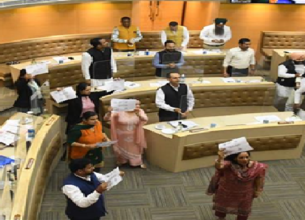ASSAM NRC: WHO IS AN INDIAN CITIZEN? HOW IS IT DEFINED?
31, Aug 2019

Prelims level : Polity- Constitution, Citizenship
Mains level : GS-II- Indian Constitution- historical underpinnings, evolution, features, amendments, significant provisions and basic structure.
Why in News?
- In the run-up to the publication of the final National Register of Citizens (NRC) in Assam, citizenship has become the most talked about topic in the country.
- The Assam government has been taking various steps in relation to those who will be left out of the NRC, while the Supreme Court last week rejected a plea to include those born in India between after March 24, 1971 and before July 1, 1987 unless they had ancestral links to India.
- In any other Indian state, they would have been citizens by birth, but the law is different for Assam.
How is Citizenship Determined in India?
- Citizenship signifies the relationship between individual and state. It begins and ends with state and law, and is thus about the state, not people. Citizenship is an idea of exclusion as it excludes non-citizens.
- There are two well-known principles for grant of citizenship:
- Jus soli: confers citizenship on the basis of place of birth,
- Jus sanguinis: gives recognition to blood ties.
- From the time of the Motilal Nehru Committee (1928), the Indian leadership was in favour of the enlightened concept of jus soli.
- The racial idea of jus sanguis was rejected by the Constituent Assembly as it was against the Indian ethos.
- Citizenship is in the Union List under the Constitution and thus under the exclusive jurisdiction of Parliament. The Constitution does not define the term ‘citizen’ but gives, in Articles 5 to 11, details of various categories of persons who are entitled to citizenship.
- Unlike other provisions of the Constitution, which came into being on January 26, 1950, these articles were enforced on November 26, 1949 itself, when the Constitution was adopted.
- However, Article 11 itself confers wide powers on Parliament by laying down that “nothing in the foregoing provisions shall derogate from the power of Parliament to make any provision with respect to the acquisition and termination of citizenship and all matters relating to citizenship”. Thus, Parliament can go against the citizenship provisions of the Constitution.
- The Citizenship Act, 1955 was passed and has been amended four times — in 1986, 2003, 2005, and 2015. The Act empowers the government to determine the citizenship of persons in whose case it is in doubt. However, over the decades, Parliament has narrowed down the wider and universal principles of citizenship based on the fact of birth. Moreover, the Foreigners Act places a heavy burden on the individual to prove that he is not a foreigner.
So, who is, or is not, a citizen of India?
- Article 5: It provided for citizenship on commencement of the Constitution. All those domiciled and born in India were given citizenship. Even those who were domiciled but not born in India, but either of whose parents was born in India, were considered citizens. Anyone who had been an ordinary resident for more than five years, too, was entitled to apply for citizenship.
- Article 6: Since Independence was preceded by Partition and migration, Article 6 laid down that anyone who migrated to India before July 19, 1949, would automatically become an Indian citizen if either of his parents or grandparents was born in India. But those who entered India after this date needed to register themselves.
- Article 7: Even those who had migrated to Pakistan after March 1, 1947 but subsequently returned on resettlement permits were included within the citizenship net. The law was more sympathetic to those who migrated from Pakistan and called them refugees than to those who, in a state of confusion, were stranded in Pakistan or went there but decided to return soon.
- Article 8: Any Person of Indian Origin residing outside India who, or either of whose parents or grandparents, was born in India could register himself or herself as ab Indian citizen with Indian Diplomatic Mission.
- 1986 amendment: Unlike the constitutional provision and the original Citizenship Act that gave citizenship on the principle of jus soli to everyone born in India, the 1986 amendment to Section 3 was less inclusive as it added the condition that those who were born in India on or after January 26, 1950 but before July 1, 1987, shall be Indian citizen.
- Those born after July 1, 1987 and before December 4, 2003, in addition to one’s own birth in India, can get citizenship only if either of his parents was an Indian citizen at the time of birth.
- 2003 amendment: The then NDA government made the above condition more stringent, keeping in view infiltration from Bangladesh. Now the law requires that for those born on or after December 4, 2004, in addition to the fact of their own birth, both parents should be Indian citizens or one parent must be Indian citizen and other should not be an illegal migrant. With these restrictive amendments, India has almost moved towards the narrow principle of jus sanguinis or blood relationship. This lays down that an illegal migrant cannot claim citizenship by naturalisation or registration even if he has been a resident of India for seven years.
- Citizenship (Amendment) Bill: The amendment proposes to permit members of six communities — Hindus, Sikhs, Buddhists, Jains, Parsis and Christians from Pakistan, Bangladesh and Afghanistan — to continue to live in India if they entered India before December 14, 2014. It also reduces the requirement for citizenship from 11 years out of the preceding 14 years, to just 6 years.
- Two notifications also exempted these migrants from the Passport Act and Foreigner Act. A large number of organisations in Assam protested against this Bill as it may grant citizenship to Bangladeshi Hindu illegal migrants.
What is different in Assam?
- The Assam Movement against illegal immigration eventually led to the historic Assam Accord of 1985, signed by Movement leaders and the Rajiv Gandhi government. Accordingly, the 1986 amendment to the Citizenship Act created a special category of citizens in relation to Assam.
- The newly inserted Section 6A laid down that all persons of Indian origin who entered Assam before January 1, 1966 and have been ordinary residents will be deemed Indian citizens.
- Those who came after 1 January, 1966 but before March 25, 1971, and have been ordinary residents, will get citizenship at the expiry of 10 years from their detection as foreigner. During this interim period, they will not have the right to vote but can get an Indian passport.
- Identification of foreigners was to be done under the Illegal Migrants (Determination by Tribunal) Act, (IMDT Act), 1983, which was applicable only in Assam while the Foreigners Act, 1946 was applicable in the rest of the country.
- The provisions of the IMDT Act made it difficult to deport illegal immigrants. On the petition of Sarbananda Sonowal (now Chief Minister), the Act was held unconstitutional and struck down by the Supreme Court in 2005.
- This was eventually replaced with the Foreigners (Tribunals of Assam) Order, 2006, which again was struck down in 2007 in Sonowal II.
- In the IMDT case, the court considered classification based on geographical considerations to be a violation of the right to equality under Article 14. In fact, another such variation was already in place. While the cut-off date for Western Pakistan is July 19, 1949, for Eastern Pakistan the Nehru-Liaquat Pact had pushed it to 1950.








